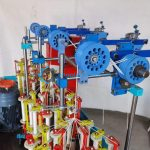Velocity and Position Sensors commonly found in motor control circuits
Tachometer generators provide a convenient means of converting rotational speed into an analog voltage signal that can be used for motor speed indication and control applications.
Temperature Sensors commonly found in motor control circuits
There are many types of temperature sensors that will use various technologies and have different configurations. The four basic types of temperature sensors commonly used today are thermocouple, resistance temperature…
Motor Control Fundamentals
The focus will be limited to single- and three-phase induction motors because they constitute the vast majority of motors the construction electrician will encounter in the field.
PLC Handbook: Practical Guide to Programmable Logic Controllers
Content Chapter 1 – What is a PLC Chapter 2 – History of the PLC Chapter 3 – How to Choose a Controller Chapter 4 – PLC Hardware Chapter –…
Understanding Motor Controls
Understanding Motor Controls assumes that the student has no knowledge of motor controls. The student is expected to have knowledge of basic Ohm's law and basic circuits, such as series,…
Beginner’s Guide To Reading Schematics
You’ll learn the rationale of schematics, how to draw or interpret each symbol, and how the symbols interconnect to form functional circuits.
Electric Motor Control
Electric motors are so much a part of everyday life that we seldom give them a second thought. When we switch on an electric drill, for example, we conWdently expect…
Basic Electrical Engineering
Chapter 1 Fundamentals of Electricity. Chapter 2 D.C. Circuits Chapter 3 Magnetic Circuits Chapter 4 Electromagnetic Induction Chapter 5 Electrostatics Chapter 6 A.C Fundamentals Chapter 7 Single Phase A.C Circuits…
Photoelectric Sensors commonly used
A photoelectric sensor is an optical control device that operates by detecting a visible or invisible beam of light, and responding to a change in the received light intensity.
Proximity sensors commonly found in motor control circuits
Proximity sensors detect the presence of an object (usually called the target) without physical contact. Detection of the presence of solids such as metal, glass, and plastics, as well as…






